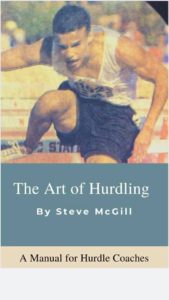February 6, 2020
In my book, The Art of Hurdling: A Manual for Coaches, I explain how I approach hurdling, and coaching hurdlers, from a 1-2-3 perspective. The seeds of this approach began, unbeknownst even to myself, when I was diagnosed with aplastic anemia during my teen years. My doctor informed me that this blood disease is characterized by bone marrow failure—the bone marrow ceases to produce new blood cells, so the victim slowly runs out of blood. Blood, my doctor explained, is comprised of three types of cells: red blood cells, which carry oxygen to all parts of the body; white blood cells, which serve to fight off infections; and platelet cells, which prevent bleeding and bruises. His brief hematology lesson gave me insight as to why I had been feeling tired all the time (low red cell count), why I’d been getting a weird whirring sound in my ears (low white cell count), and why random bruises would sometimes appear on my arms and feet (low platelet cell count).
It wasn’t until years later—after I had made a full recovery, graduated from college and then grad school, and then began working full-time—that I found myself contemplating the wonder of it all. These three types of cells work together to create a harmonious balance, a marvelous tapestry of rhythm in motion to protect the body from internal and external threats. If there is an imbalance in any of the three, there is an imbalance in the entire system, and therefore in the entire body, which can lead to a myriad of possible catastrophes. And yet, until we get sick, we don’t even think about how fragile our health is, and all the things that could possibly go wrong.
Once I latched onto this 1-2-3 concept in terms of blood cells, I took note of it in other aspects of life as well. The three primary colors, the three components of an atom, the body-mind-spirit of the human being, the holy trinities of several religious traditions, etc. So much in life, I observed, seems to have this 1-2-3 thing going on at a fundamental level. And if that’s true of so much in life, I reasoned, then it must be true of the hurdles.
And of course, it is. In hurdling, the three basic components are technique, rhythm, and speed. If any of these three is deficient in some way, then the other two are forced to compensate, throwing off the delicate balance that is so essential to fluid, effortless hurdling. Just like none of the three types of blood cells is more important than the other two, none of the three key components of hurdling is more important than the other two. Therefore, all three—technique, rhythm, and speed—most be trained together, so that they are in harmony with one another. And developing all three is a season-long, career-long journey.
In my book, The Art of Hurdling: A Manual for Hurdle Coaches, I discuss the training methods I use to develop these three basic components of hurdling, as well as the 1-2-3 action of the lead leg, trail leg, and lead arm. I discuss how to develop them all individually, and how to put them all together. If you’d like to learn more, click here to purchase a copy.

